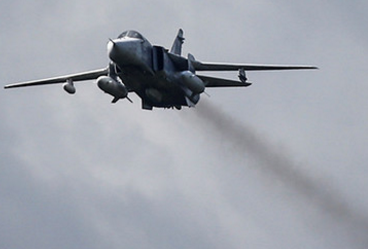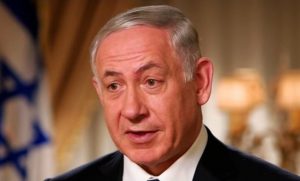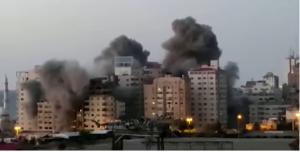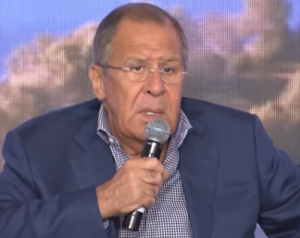
The Times of Israel: The Israeli Air Force attacked four Hamas targets in the Gaza Strip overnight Friday-Saturday, including two weapons production sites, a weapons depot, and another training compound, in retaliation for rocket fire at Israel from the Hamas-controlled enclave.
On Saturday, the Hamas-run health ministry said two people were killed in one of the strikes, on a Hamas facility in Nusseirat in the central Gaza Strip.
The attack was carried out in response to rocket fire from the Gaza Strip on Friday. One of the rockets exploded in the Israeli town of Sderot Friday night, causing damage to several parked cars.
There were no casualties, though two people were treated for anxiety.
“The IDF views the shooting at Israeli communities severely,” the IDF said in a statement. “Hamas is solely responsible for what happens in the Gaza Strip.”
“There was a huge explosion. I heard glass shatter and car alarms. The house’s walls shook,” a resident told the Ynet news website.
The rocket was the third launch of the evening, and came shortly after Israel struck Hamas targets in Gaza in response to the previous projectile-fire.
In an earlier Israeli response, the IDF said it hit a Hamas training facility and a weapons depot belonging to the terror group.
The Hamas-run health ministry in Gaza said that in the first round of Israeli strikes14 people were wounded, suffering what it described as light to moderate injuries. Reuters reported that as many as 25 people were wounded, including six children.
Witnesses told the news agency that most of the casualties were not Hamas men but civilians who lived in a building near the training camp.
Hamas, an Islamist terror group which seeks to destroy Israel, has called for a new intifada in response to US President Donald Trump’s recognition on Wednesday of Jerusalem as Israel’s capital. Hamas’s leader Ismail Haniyeh on Friday evening praised as a “blessed intifada” the violent protests held by thousands of Palestinians across the West Bank and in Gaza throughout the afternoon. Two Gazans were reported killed in what Israel said were violent protests at the Gaza border fence and a third was badly injured.
Israel holds Hamas responsible for all rocket fire and other attacks emanating from the Strip, which the terror group still overwhelmingly controls despite handing over some power back to the Palestinian Authority.
The strike on Hamas positions came shortly after the army said its Iron Dome missile defense system intercepted a rocket fired from Gaza. Sirens blared in communities near the Gaza border soon afterwards, as a second rocket was fired. The army said it did not identify an impact.
The IDF said there were no injuries or damage from those earlier rockets.
The military had warned more rockets could follow, and told residents of the Gaza periphery to remain close to protected spaces and bomb shelters.
The Israeli army said around Palestinians “participated in violent riots at six locations along the border with the Gaza Strip.” It said troops shot at some of the rioters, but did not specify how many were wounded.
A number of rockets were fired at Israel from Gaza on Thursday, as Hamas leader Ismail Haniyeh called for a new Palestinian intifada, or uprising. An IDF tank and aircraft carried out retaliatory strikes on two Hamas positions.
The army sent soldiers to inspect the area for signs of impact, but, finding none, determined that the two rockets had not reached Israeli territory, a spokesperson said.
In the hours afterward, the Tawhid al-Jihad group claimed responsibility for the attack on social media. The small, radical group is affiliated with al-Qaeda.
The launches came five weeks after the Israeli military destroyed an attack tunnel belonging to the Palestinian Islamic Jihad terrorist group, which crossed into Israel from the Gaza Strip. In the blast and its aftermath, 12 members of the terrorist group were killed, along with two Hamas operatives.
Last week, the Islamic Jihad launched a dozen mortar shells at an army post northeast of the Strip, causing no injuries but some damage to army equipment.
The military retaliated with six strikes on terrorist positions in Gaza, four of them belonging to the Islamic Jihad and two to Hamas, which rules the coastal enclave.
In a Wednesday address from the White House, Trump defied worldwide warnings and insisted that after repeated failures to achieve peace a new approach was long overdue, describing his decision to recognize Jerusalem as the seat of Israel’s government as merely based on reality.
The move was hailed by Israel’s Prime Minister Benjamin Netanyahu and by leaders across much of the Israeli political spectrum. Trump stressed that he was not specifying the boundaries of Israeli sovereignty in the city, and called for no change in the status quo at the city’s holy sites.
Trump also said the United States would move its embassy from Tel Aviv to Jerusalem, though he set no timetable for that.
Jerusalem’s status is among the most difficult issues in the Israeli-Palestinian conflict, and the US’s traditional position has been that it must be negotiated between the two sides.
While Israel has always considered Jerusalem its capital, with the prime minister’s office and parliament building located there, countries have avoided recognizing it as such to prevent damaging hopes for a two-state solution.
The Palestinians seek the eastern sector of the city as the capital of their future state.




